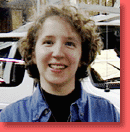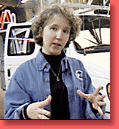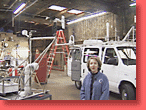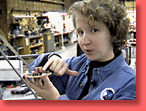|
D a
p h n e Z a r a s
 |
|
Daphne
Zaras
Research Meteorologist NSSL/OAR/NOAA
|
"All
things are delicately interconnected."
Jenny
Holzer, contemporary American artist
Hi,
my name is Daphne Zaras and I’m a research meteorologist at the
National Severe Storms Laboratory in Norman, Oklahoma. I am on the Web
team for the Lab, still do a little bit of research and am part of a
team that creates training materials for National Weather Service forecasters.
I bring teaching, communication, and computer skills to our Web team,
which I find very fun. A big part of our website is to communicate our
science to people interested in learning more about it! It took me a
long time to get where I am, and to figure out how to combine my interests
into a job I would love.
In
junior high and high school I planned to be a teacher. At first I thought
I’d teach math, but after taking physics my senior year I changed
my mind. Teaching physics would be a lot of fun! However, my parents
are both teachers so they encouraged me to initially go for the physics
major itself in college (rather than major in education and take some
physics courses) and be sure I found out what else there was to do with
a science degree before deciding teaching was for me. This decision
was the beginning of my journey, but key in me being able to get where
I am today.
 I
started out in college as a physics major at Anderson University in
Anderson, Indiana. It was a tough major, but my professors were really
encouraging. They thought I had what it took to be a physicist. When
nearby Indiana University decided to run a summer research program for
people like me who were uncertain about what they might want to do with
a physics degree, my professors encouraged me to apply. I did and was
selected as one of 10 students to spend 10 weeks at the Indiana University
Cyclotron Facility in Bloomington, Indiana. I had a lot of fun seeing
some of what you could do with physics. My project was to see if we
could tell how many atoms thick a thin lead foil was by measuring the
amount of radiation that got through the foil. I got to make my own
foils for my project (using rollers to make what looks like aluminum
foil but was made of lead), and got to design two other parts and make
one of them myself in the machine shop. My favorite experiences of the
summer were the hands-on activities and meeting interesting people.
However, the summer left me thinking that although I liked research,
I wasn’t sure I wanted to do nuclear physics research. I
started out in college as a physics major at Anderson University in
Anderson, Indiana. It was a tough major, but my professors were really
encouraging. They thought I had what it took to be a physicist. When
nearby Indiana University decided to run a summer research program for
people like me who were uncertain about what they might want to do with
a physics degree, my professors encouraged me to apply. I did and was
selected as one of 10 students to spend 10 weeks at the Indiana University
Cyclotron Facility in Bloomington, Indiana. I had a lot of fun seeing
some of what you could do with physics. My project was to see if we
could tell how many atoms thick a thin lead foil was by measuring the
amount of radiation that got through the foil. I got to make my own
foils for my project (using rollers to make what looks like aluminum
foil but was made of lead), and got to design two other parts and make
one of them myself in the machine shop. My favorite experiences of the
summer were the hands-on activities and meeting interesting people.
However, the summer left me thinking that although I liked research,
I wasn’t sure I wanted to do nuclear physics research.
When
I finished my physics degree, I thought I’d go on to graduate school
in something else but was unsure what it should be. In my last summer
as I was finishing the last math class for my degree I started making
phone calls. One was to a medical physics department and a couple were
to meteorology departments.
 It
was the meteorology department at the University of Wisconsin- Madison
that was the hit. They were delighted to hear from a physics undergraduate
student and when they heard my test scores on the GRE (the graduate
school test similar to the SAT or ACT high school students take to go
to college) they wanted me to go there. They invited me to visit and
thought they could even pay me a research assistantship to go there!
This was great news since my parents had already told me I would have
to pay for graduate school myself. [Note that this is the case for most
of the physical sciences, that graduate students get paid a small amount
to attend school. It isn’t much, poverty-level, but when you’re
in school you are not doing things like buying a house. It’s just
enough to live on.] It
was the meteorology department at the University of Wisconsin- Madison
that was the hit. They were delighted to hear from a physics undergraduate
student and when they heard my test scores on the GRE (the graduate
school test similar to the SAT or ACT high school students take to go
to college) they wanted me to go there. They invited me to visit and
thought they could even pay me a research assistantship to go there!
This was great news since my parents had already told me I would have
to pay for graduate school myself. [Note that this is the case for most
of the physical sciences, that graduate students get paid a small amount
to attend school. It isn’t much, poverty-level, but when you’re
in school you are not doing things like buying a house. It’s just
enough to live on.]
Madison
was great and I really liked meteorology. I got to work with some of
the satellite experts there for my master’s thesis. Although the
thesis work was very specific, my courses covered all aspects of meteorology.
My favorite class turned out to be environmental biophysics, where we
studied plants and the weather. This included how sunlight and rainfall
are intercepted by leaves of plants and how water infiltrates the soil,
among other things. I also liked the synoptic meteorology courses where
we studied weather maps and tried to forecast the weather.
 I
got to do a few fun things including participating in the National Forecasting
Contest. I actually won one of the forecasting periods! I have the dubious
distinction of being the best graduate student forecaster for Spokane,
Washington for two weeks in February of 1992. Another forecasting contest
offered my friends and I some fun: we got together and secretly entered
the Farmer’s Almanac forecasts into our own department’s forecasting
contest. During the first two weeks our fake forecaster was doing really
well. However, by the end of the contest, "he" was terrible:
worse than either climatology (average weather conditions) or persistence
(if it rains today, forecast rain for tomorrow; if sunny today, assume
also sunny tomorrow)! I
got to do a few fun things including participating in the National Forecasting
Contest. I actually won one of the forecasting periods! I have the dubious
distinction of being the best graduate student forecaster for Spokane,
Washington for two weeks in February of 1992. Another forecasting contest
offered my friends and I some fun: we got together and secretly entered
the Farmer’s Almanac forecasts into our own department’s forecasting
contest. During the first two weeks our fake forecaster was doing really
well. However, by the end of the contest, "he" was terrible:
worse than either climatology (average weather conditions) or persistence
(if it rains today, forecast rain for tomorrow; if sunny today, assume
also sunny tomorrow)!
|

 I
started out in college as a physics major at Anderson University in
Anderson, Indiana. It was a tough major, but my professors were really
encouraging. They thought I had what it took to be a physicist. When
nearby Indiana University decided to run a summer research program for
people like me who were uncertain about what they might want to do with
a physics degree, my professors encouraged me to apply. I did and was
selected as one of 10 students to spend 10 weeks at the Indiana University
Cyclotron Facility in Bloomington, Indiana. I had a lot of fun seeing
some of what you could do with physics. My project was to see if we
could tell how many atoms thick a thin lead foil was by measuring the
amount of radiation that got through the foil. I got to make my own
foils for my project (using rollers to make what looks like aluminum
foil but was made of lead), and got to design two other parts and make
one of them myself in the machine shop. My favorite experiences of the
summer were the hands-on activities and meeting interesting people.
However, the summer left me thinking that although I liked research,
I wasn’t sure I wanted to do nuclear physics research.
I
started out in college as a physics major at Anderson University in
Anderson, Indiana. It was a tough major, but my professors were really
encouraging. They thought I had what it took to be a physicist. When
nearby Indiana University decided to run a summer research program for
people like me who were uncertain about what they might want to do with
a physics degree, my professors encouraged me to apply. I did and was
selected as one of 10 students to spend 10 weeks at the Indiana University
Cyclotron Facility in Bloomington, Indiana. I had a lot of fun seeing
some of what you could do with physics. My project was to see if we
could tell how many atoms thick a thin lead foil was by measuring the
amount of radiation that got through the foil. I got to make my own
foils for my project (using rollers to make what looks like aluminum
foil but was made of lead), and got to design two other parts and make
one of them myself in the machine shop. My favorite experiences of the
summer were the hands-on activities and meeting interesting people.
However, the summer left me thinking that although I liked research,
I wasn’t sure I wanted to do nuclear physics research. It
was the meteorology department at the University of Wisconsin- Madison
that was the hit. They were delighted to hear from a physics undergraduate
student and when they heard my test scores on the GRE (the graduate
school test similar to the SAT or ACT high school students take to go
to college) they wanted me to go there. They invited me to visit and
thought they could even pay me a research assistantship to go there!
This was great news since my parents had already told me I would have
to pay for graduate school myself. [Note that this is the case for most
of the physical sciences, that graduate students get paid a small amount
to attend school. It isn’t much, poverty-level, but when you’re
in school you are not doing things like buying a house. It’s just
enough to live on.]
It
was the meteorology department at the University of Wisconsin- Madison
that was the hit. They were delighted to hear from a physics undergraduate
student and when they heard my test scores on the GRE (the graduate
school test similar to the SAT or ACT high school students take to go
to college) they wanted me to go there. They invited me to visit and
thought they could even pay me a research assistantship to go there!
This was great news since my parents had already told me I would have
to pay for graduate school myself. [Note that this is the case for most
of the physical sciences, that graduate students get paid a small amount
to attend school. It isn’t much, poverty-level, but when you’re
in school you are not doing things like buying a house. It’s just
enough to live on.] I
got to do a few fun things including participating in the National Forecasting
Contest. I actually won one of the forecasting periods! I have the dubious
distinction of being the best graduate student forecaster for Spokane,
Washington for two weeks in February of 1992. Another forecasting contest
offered my friends and I some fun: we got together and secretly entered
the Farmer’s Almanac forecasts into our own department’s forecasting
contest. During the first two weeks our fake forecaster was doing really
well. However, by the end of the contest, "he" was terrible:
worse than either climatology (average weather conditions) or persistence
(if it rains today, forecast rain for tomorrow; if sunny today, assume
also sunny tomorrow)!
I
got to do a few fun things including participating in the National Forecasting
Contest. I actually won one of the forecasting periods! I have the dubious
distinction of being the best graduate student forecaster for Spokane,
Washington for two weeks in February of 1992. Another forecasting contest
offered my friends and I some fun: we got together and secretly entered
the Farmer’s Almanac forecasts into our own department’s forecasting
contest. During the first two weeks our fake forecaster was doing really
well. However, by the end of the contest, "he" was terrible:
worse than either climatology (average weather conditions) or persistence
(if it rains today, forecast rain for tomorrow; if sunny today, assume
also sunny tomorrow)!